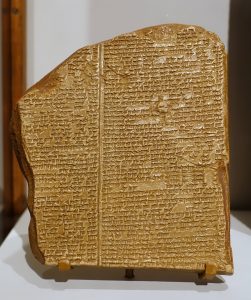
Epic of Gilgamesh
Akkadian is the Semitic language that dominated ancient Mesopotamia and much of Ancient West Asia (also known as the Ancient Near East) for nearly two millennia. It was the language of empires and peasants. It gave voice to royal epics, divine myths, treaties, covenants, adoption contracts, oaths and so much more. Among the most famous is the Laws of Hammurabi from the Old Babylonian period. The Gilgamesh Epic and Enuma Elish, too, are found in dialects of Akkadian. These dialects include, among others, different periods of Babylonian and Assyrian. As a Semitic language, Akkadian is related to Hebrew, Arabic, Aramaic, Ugaritic, Ge’ez, etc. Students who have prior experience with a Semitic language will no doubt see similarities.
The present course introduces students to the basics of Akkadian vocabulary, grammar, and syntax, enabling them to read basic prose in transliterated Akkadian. Students will learn a modest amount of cuneiform symbols of the Old Babylonian lapidary type or of the Neo-Assyrian script, so as to facilitate reading a little from the Laws of Hammurabi and a few other cuneiform texts. We will primarily work with transliterated and normalized Akkadian.
- To master basic Akkadian vocabulary
- To understand some basic morphology, grammar, and syntax of Akkadian
- To be able to translate Akkadian prose fluidly To be able to parse basic Akkadian verb forms
- To identify the values of cuneiform signs in order to read real ancient cuneiform texts
Huehnergard, John. A Grammar of Akkadian, 3rd Edition. Harvard Semitic Studies 45. Boston: Brill, 2011.
Snell, Daniel C. A New Workbook of Cuneiform Signs. Winona Lake: Eisenbrauns, 2022.